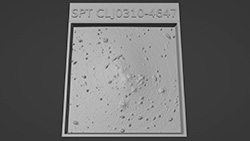CXC Home | Search | Help | Image Use Policy | Latest Images | Privacy | Accessibility | Glossary | Q&A
1
X-ray, Optical, & Infrared Brightest Cluster GalaxiesCredit: X-ray: NASA/CXC/MIT/M. Calzadilla el al.; Optical: NASA/ESA/STScI; Image Processing: NASA/CXC/SAO/N. Wolk & J. Major
These images represent a sample of galaxy clusters that are part of the largest and most complete study to learn what triggers stars to form in the universe’s biggest galaxies. Clusters of galaxies are the largest objects in the universe held together by gravity and contain huge amounts of hot gas seen in X-rays. This research, made using Chandra and other telescopes, showed that the conditions for stellar conception in these exceptionally massive galaxies have not changed over the last ten billion years. In these images, X-rays from Chandra are shown along with optical data from Hubble.
2
3D Printable Files: Brightest Cluster Galaxy SPT-CLJ0310-4647(3D Print Credit: NASA/CXC/A. Jubett, using software by Tactile Universe/N. Bonne & C. Krawczyk & Blender)
This tactile plate features a physical relief map based on the intensity of X-ray and Optical data, depicting the galaxy cluster named SPT-CLJ0310-4647. The plate features a slightly-raised cloud representing X-rays from hot gas observed by Chandra. The distant galaxies in and around the clouds of hot gas have been captured in optical data, and are raised above the plane of the X-ray cloud.
The vastness of space is packed with specks. These are the individual galaxies. Some of the galaxies resemble fuzzy-edged dots. In other galaxies, the curving arms of a spiral formation are discernible. At the center of the image, the more indistinct X-ray cloud surrounds several of the cluster’s most prominent galaxies.
The vastness of space is packed with specks. These are the individual galaxies. Some of the galaxies resemble fuzzy-edged dots. In other galaxies, the curving arms of a spiral formation are discernible. At the center of the image, the more indistinct X-ray cloud surrounds several of the cluster’s most prominent galaxies.
Return to: Astronomers Find Spark of Star Birth Across Billions of Years (January 11, 2024)


















